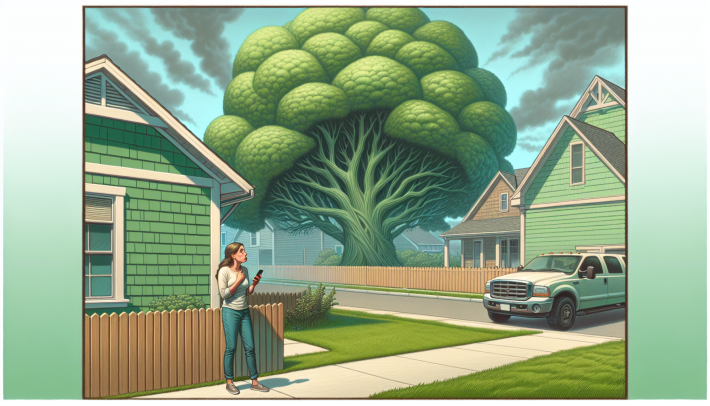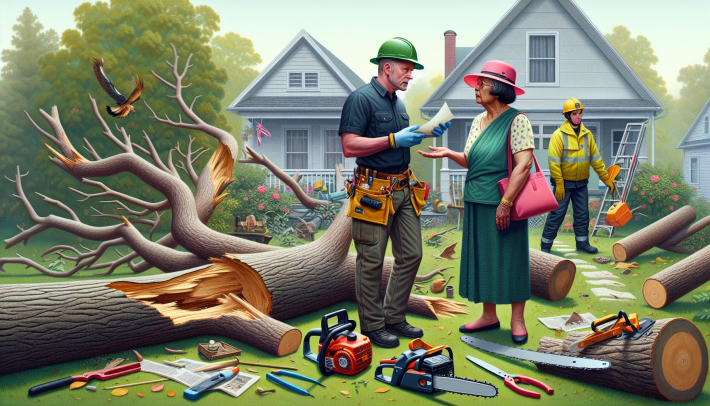Techniques to Determine Tree Location and Ownership

Determining Property Lines
Finding out where our land stops and starts is like uncovering a family secret—it’s crucial when dealing with nosy neighbors or claiming tree ownership. Here, we’re diving into the importance of knowing where our patch ends and the next begins, along with legal ins and outs.
What’s the Big Deal with Boundary Lines?
Think of property lines like a referee at a soccer match—setting clear boundaries to avoid folks stepping on each other’s toes. Not only do they keep peace with neighbors over that pesky branch hanging across the fence, but they also stop confused gazes at each other’s yards. Knowing our terrain can keep feuds from blossoming like untamed weeds, particularly when plotting additions, manicuring your grass jungle, or starting construction escapades.
When we need to decide who’s land begins where, a land survey is our best friend, giving us the lay of the land straight from the geographic horse’s mouth. It’s a good move before digging post holes, slotting in new trees, or widening the driveway. Don’t forget—tapping into the info hotline 811’s mandatory in a lot of places before shoveling starts.
| Survey Type | Estimated Damage to the Wallet |
|---|---|
| Land Survey | $330 – $670 |
Snagging a licensed land surveyor might cost a few nickels, but it’s crystal-clearing our boundary lines. They’ll dig through county archives and behold easements, subdivisions, and other head-scratchers that matter.
Legal Whoopsies Around Property Lines
Let’s not get bogged down in legal uproar over trivial border skirmishes. Digging into our property’s deed can unravel the puzzle of our exact land limits. A quick trip to the county recorder’s hive might clear up grid confusion.
Sometimes property lines get charted out by what’s called a metes and bounds survey. This loftily names stuff that we can actually see—trees, roads, etc. But beware! Those trees tend to pull a Houdini on occasion. Double-checking with a compass keeps things precise like a hawk’s gaze (Redfin).
Grasping the weight of boundary lines and fully understanding legal aftermath opens us up to face neighbor-tree quibbles with gusto. In times of doubt, chats with legal eagles or intense analysis of those lines can prevent future hoo-has. If we ever find ourselves in a tizzy over a neighbor’s sketchy branch, don’t hesitate to explore more on topics like winging it with dangerous trees next door or going uninvited in chopping neighbor’s trees.
Establishing Ownership of Trees
Figuring out who exactly owns a tree becomes a big deal when you bump into those pesky neighborly disputes. So, let’s learn the ground rules about who owns what tree and how the ones that stand on property lines are handled.
Tree Ownership Rules
Tree ownership laws aren’t the same everywhere, but here’s a basic rule we’ll work with: if even a teeny bit of a tree trunk is on our turf, it’s ours. Pinning down those property boundaries is super important for getting a hold on this tree ownership stuff (American Climbers).
| Tree Location | Ownership |
|---|---|
| Trunk entirely on our land | That tree’s ours. |
| Trunk on the shared line | Both folks have a stake in it. |
| Just branches/roots on our side | Nope, not ours. |
When a tree’s trunk is slap-bang on the property line, it turns into a group project. Both owners gotta share the care and costs. Each neighbor can mess with those annoying branches that cross into their space without having a neighborly powwow, though dropping a heads-up isn’t a bad idea. This kind of thing screams for some good chatting and planning between neighbors (American Climbers).
Boundary Line Trees
Trees hanging out on the boundary line are like the kids of two households—both neighbors share custody. Duties like giving the tree some water and a little haircut are split between you and the folks next door. But if it’s just the branches or roots snooping past the line, it doesn’t mean the neighbor gets a slice of the tree pie Ohio State University Extension.
In simple words:
- Want that tree gone? Ya both got to nod in agreement.
- If branches peek over into your space, you’ve got the green light to snip away, but maybe knock on your neighbor’s door first just to keep the peace.
Understanding who holds the reins on tree ownership helps knock out any rough patches and makes sure everyone’s on the same page about their rights and duties. If tangled in a tree war or need backup on tree care, dive into useful reads like what to do if your neighbor’s tree is affecting you and neighbors tree roots causing damage to my foundations or pipes.
Neighbor’s Tree on Your Property
When we’re dealing with a neighbor’s tree that’s edging onto our patch of grass, it’s vital to know who pays for what if things go south, along with the best way to sort it out. A bit of neighborly chit-chat coupled with some homework on local rules can keep us from getting into a twist over the issue.
Liability for Damages
Figuring out who’s on the hook when a neighbor’s tree gets a little too cozy with our property depends on a few details. We need to know if the neighbor knew—or should’ve known—that the tree might cause trouble. Homeowners gotta make sure their trees aren’t a threat to those living next door. If one of their trees takes a tumble into our yard, they might have to pick up the tab, especially if that tree was already looking sorry for itself or had a lousy root system (JustAnswer, Ohio State University Extension).
| Condition | Potential Liability |
|---|---|
| Tree is healthy | Likely not liable |
| Tree is weak/diseased | Might be their problem if they knew |
| Tree causes damage | Could be liable |
Knowing these ins and outs helps us decide if we need to chat with our neighbor about any costs or repairs that could be coming their way.
Dealing with Neighbor’s Tree
When a neighbor’s tree starts to cause a bit of chaos in our yard, we’ve got options to sort it out without losing our cool. Here’s what we can do:
-
Friendly Chat: Start by having a word with our neighbor. Chances are they don’t even know there’s a problem. A heads-up can often lead to quick fixes.
-
Keep a Record: Make a note of the mess or any damage—snap a few photos or jot down a bit of a diary. If push comes to shove, it’s good to have a paper trail.
-
Local Laws and Rules: Sometimes, it helps to check out what the local code or a homeowners’ group might say about tree disputes. They might have rules that cover this sort of thing.
-
Seek Legal Help: If a cordial discussion doesn’t get us anywhere, legal advice might be the next step. We’ll need to get a grip on the property laws concerning tree ownership. For example, if we want to trim or chop down parts of the pesky tree, it’s important to know if we can do so without their say-so.
For more know-how, we can check out links such as who is responsible for fallen tree removal or what to do if your neighbor has a dangerous tree. Staying clued-up ensures we keep friendly ties with our neighbors while standing up for what’s ours.
Maintenance Responsibilities
Taking care of trees near property lines can be a puzzler, but it’s key to figure out who’s on the hook for what. We all want to do right by our leafy neighbors and the folks living next door.
Tree Care on Property Lines
Ever found yourself wondering whose job it is to look after a tree that sits snugly on the line between properties? You’re not alone! In this situation, neighbors split the load of ownership and responsibility. It’s kind of like both owning a dog, except this one’s rooted in place and doesn’t eat your socks. The best way forward? Chat it up with your neighbor about what needs doing, what hazards might pop up, and how you can share the work.
If a tree decides to take a little stroll and dip its branches into your yard, you’ve got the okay to give those branches a trim. But if the trunk is all on your neighbor’s turf, they’re the boss of the whole show. Remember, talking things through can keep things friendly and ensure everyone’s hedges and happy faces stay neat.
| Property Line Scenario | Responsibility |
|---|---|
| Tree on boundary line | Shared load for both neighbors |
| Trunk wholly on one’s land | Other can trim branches crossing over |
Trimming Overhanging Branches
Feel like those branches hanging over your property are throwing some unwanted shade? You can totally trim them back, but it’s crucial to be careful. Go all Edward Scissorhands and you might end up responsible for a wilting or, gah, dead tree if trimming goes awry.
Grab the right tools, and aim for a smooth snip to keep the tree happy and healthy. Giving your neighbor a heads-up is just good manners, especially if your trimming might make their tree feel under the weather.
If a neighbor’s tree is being a bad guest and messing up your shingles or something, it’s best to handle it with kindness and maybe a nice chat over a cup of coffee. We’ve got tips on handling damage with articles like neighbors tree causing damage to your roof what to do and what to do if your neighbors tree is affecting you.
Knowing where our care duties lie with trees helps keep our yards spiffy and our neighborly ties strong. A little communication and careful pruning go a long way in keeping everyone’s property and peace in one piece.
Legal Framework and Rights
Getting a grip on tree ownership laws can really help when we find ourselves dealing with trees that play peek-a-boo with property lines. Let’s dive into how the rules swing in Ohio and what that means for our leafy responsibilities.
Laws on Tree Ownership
Laws about who owns a tree can change a lot from place to place. But usually, when a tree’s smack dab on a line splitting two properties, both neighbors share custody. That means deciding its fate—whether it’s getting TLC or the chop—has to be a joint effort.
Now, just because branches or roots wander into next door doesn’t mean the whole tree is up for grabs. Each of us gets to look after our piece of the pie and clip away at any overhanging branches or roots, as long as we’re not out there hacking away like it’s a slasher film. Botching up the job could mean we’re on the hook for damages.
Ohio Property Regulations
Ohio has its own playbook when it comes to tending to trees. The Ohio Revised Code 901.51 says if you mess up someone else’s greenery, like a tree or vine, you might be coughing up triple the damages. So, treading carefully around others’ plants helps everyone sleep better at night.
What if a neighbor’s tree decides to break and enter—landing on our turf? They’re only on the hook if they knew it was a ticking time bomb, disease-wise. If all was quiet on the health front, they might skate by without facing costs.
And for the sake of good vibes, if a neighbor’s tree takes a tumble onto our property, it’s nice to let them know. Even though Ohio law doesn’t spell out the fate of fallen timber, giving them a heads-up shows neighborly respect. Keeping records of this can help avoid drama down the line.
By knowing these rules and practicing a little kindness, we can manage our tree situations smoothly and keep things friendly across the fence.
Making Sense of Boundaries
Figuring out neighbor and tree rights is like getting directions in a spaghetti junction—confusing, to say the least. We gotta get our facts straight about where our property starts and ends, so let’s map this out together.
Getting Our Bearings with Land Surveys
Think of a land survey as the Google Maps of property lines. Before we go building fences or planting that mighty oak, we need one of these bad boys. It’ll set us back around $330 to $670, but hey, it’s worth it according to Redfin. The surveyor’s like a property detective, digging through county files and unraveling the land’s backstory—easements, subdivisions, the whole shebang.
Ever heard of a metes and bounds survey? It’s like creating a map using real-life markers like that big ol’ tree out back or the stream cutting through the yard. But, since trees don’t always stay put, double-checking these markers is smart. Grab a compass and see if north really is where it’s supposed to be.
| Type of Survey | Cost Guess ($) | What It Does |
|---|---|---|
| Typical Land Survey | 330 – 670 | Spots the nitty-gritty of boundaries |
| Metes and Bounds Survey | YMMV | Uses Mother Nature’s landmarks |
Double-Checking the Fine Print
Property deeds are like the OG Google Docs for land—spelling out every little detail about taxes and boundaries. We can snag these documents online or hit up our county recorder’s office. They’re key to knowing what’s ours and what’s not.
Don’t forget the 811 hotline; it’s like checking for buried treasure, but you’re checking for cables and pipes instead. Before putting up a new shed, it’s smart to make that call and stay on the right side of the law (Redfin).
By laying the groundwork with these steps, we’re not just claiming our territory, we’re also sidestepping any dramas about which tree belongs to whom. This savvy approach keeps us in the know and our neighborly relations peachy.



